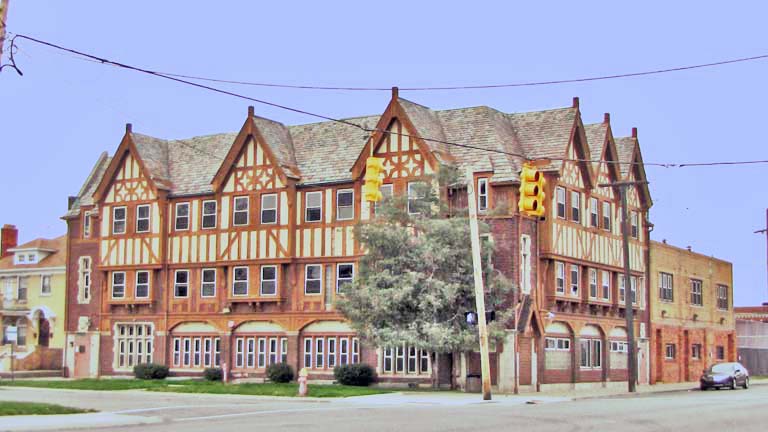

This very attractive Tudor Building seems out of place in this rather run-down area along Linwood, but it is strongly linked to Detroit’s history and development. The 1920s were the years of the city’s fastest growth as Detroit became the true international capital for the vehicle industry. Residents needed homes: expensive residences were constructed for the prosperous such as those found in Indian Village and Sherwood Forest, but much more modest homes were constructed for those who built the cars.
George Miller and Arthur Storm organized their company in 1921 with the aim of building homes for the growing market. I believe they also sold plans for homes and some of the components needed to erect them. By the mid-1920s, the firm was sufficiently prosperous to construct the appealing building that you see pictured here. Apparently, the firm called this building “The Home of Homes.” The company’s offices were on the upper floors, while the street-level area was used to display the homes they could build and the equipment they might use in these new homes. I infer that Miller-Storm was a very successful firm in the 1920s.
One of their accomplishments was the construction of the Mark Twain Development built between 1927 and 1931 in the 11,300 block of Mark Twain on the city’s West Side. As of now, there is no picture of that neighborhood on this website. This company published two books to promote their endeavors: 1000 Ideas for Your Home (1928) and Good Homes: A Book Designed to Help You Plan, Finance and Equip Your Home. (1929).
Charles Noble was a productive architect in Detroit in the 1920s. Two of his apartment buildings—Kean and Lee Plaza—are described on this site. For this Miller-Storm building, Noble incorporated half-timbering and gable dormers on both of the sides that face street. Display windows were used at the lower level but I believe they were removed when the building was converted to residences.
The migration of many white Detroit residents from the city to the suburbs in the 1950s, 1960s and 1970s, and the current migration of African Americans from the city to the suburbs, has greatly reduced the demand for housing in the city and left behind a low-income population. In 2012, the Census Bureau released census tract data from five years of surveys. The neighborhood that includes the Miller-Storm Building has a population that was 98 percent black. The median household income in the neighborhood was $19,000—far below the $52,400 figure for metropolitan Detroit. Forty-two percent of the people in this area lived in impoverished households compared to a 16 percent figure for the metropolis and 42 percent of the nearby housing units were vacant.
Architect: Charles Noble
Architectural Style: Tudor
Date of Construction: 1927
Use in 2012: Residential Building
City of Detroit Designated Historic District: Not listed
State of Michigan Registry of Historic Sites: Not listed
National Register of Historic Places: Not listed
Photograph: Ren Farley; November 19, 2012
Description prepared: December, 2012